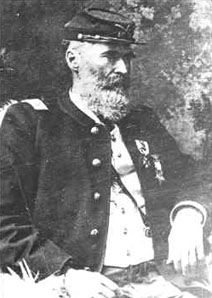| Eugene Asa Carr  Born: 20-Mar-1830 Born: 20-Mar-1830
Birthplace: Concord, NY
Died: 2-Dec-1910
Location of death: Washington, DC
Cause of death: unspecified
Remains: Buried, US Military Academy, West Point, NY
Gender: Male
Race or Ethnicity: White
Sexual orientation: Straight
Occupation: Military Nationality: United States
Executive summary: Union Army General Military service: US Army; Union Army The American soldier Eugene Asa Carr was born in Erie county, New York on the 20th of March, 1830. He was graduated at the United States military academy in 1850, and entered the mounted rifles. In 1852-53 he accompanied expeditions to the Rocky mountains. In a skirmish with the Mescalero Apaches, near Diablo mountain, 10 October, 1854, he was severely wounded, and for his gallantry was promoted first lieutenant. He took part in the Sioux expedition of 1855, was engaged in suppressing the Kansas border disturbances in 1856, and was in the Utah expedition of 1858, receiving promotion as captain on 11 June 1858. In 1860 he took part in skirmishes with the Kiowa and Comanche Indians, and in May 1861, marched from Fort Washita to Fort Leavenworth, and at once entered upon active service in the field in General Lyon's campaign in southwestern Missouri. He was engaged at Dug Springs and in the battle of Wilson's Creek, where he won the brevet of lieutenant colonel for gallantry. In September 1861 he was commissioned colonel of the 3rd Illinois volunteer cavalry, was an acting brigadier-general in John C. Fremont's hundred days' campaign, served under Hunter, Halleck, and Curtis, was assigned, February 1862, to the command of the fourth division of the Army of the Southwest, and participated in the pursuit of the enemy into Arkansas, holding the rank of brigadier-general, having received his commission on 7 March 1862. At Pea Ridge he deployed his division on the extreme right in the second day's battle, and, though thrice wounded, held his position for seven hours, contributing in a large measure to the victory of the day. For his gallantry he was made brigadier-general of volunteers, dating frcm 7 March, and was assigned a command under General Curtis. He participated in the operations against Little Rock, and in the march to Helena during the summer of 1862, was promoted major in the regular army 17 July, and during the autumn of 1682 commanded the Army of the Southwest. During the Vicksburg campaign of 1863 he commanded a division and led the attack at Magnolia Church and at Port Gibson. At Big Black River his division led the column, and opened and closed the engagement, for which he was brevetted colonel, United States army. He led the assault on Vicksburg on the 18th of May, and on the 22nd his division was the first to effect a lodgment in the enemy's works. During the autumn of 1863 he commanded at Corinth the left wing of the 16th corps, was transferred in December to the Army of Arkansas, was engaged in the expedition against Camden and in the action at the Little Red River, was in command at Poison Spring and took part in the engagements at Prairie D'Ane and Jenkins's Ferry. He was engaged at Clarendon, 20 June 1865 and distinguished himself at the siege of Spanish Fort. He was brevetted brigadier-general in the United States Army for gallantry at Little Rock, and major-general for services during the war. He took the field against the hostile Sioux and Cheyennes in October 1868, and on 18 October defeated a large party of Cheyennes on Beaver Creek, Kansas; routed them on Solomon River on 25 October, and drove them out of Kansas; commanded an expedition to the Canadian River in the winter of 1868-9, and one to Republican River in June and July 1869, defeating Tall Bull at Summit Springs, Colorado on 11 July 1869, and securing a lasting peace to the frontier. He was promoted lieutenant colonel on 17 June 1873, participated in a campaign against the Sioux in 1876, afterward commanded the Black Hills district, and was chief officer of the Big Horn and Yellowstone expedition in the autumn of that year. He was promoted colonel of the 6th cavalry, to date from 29 April 1879, directed the field operations against the hostile Apaches in Arizona and New Mexico in 1880, and commanded the expedition to Old Mexico during the Victoria campaign. In August 1881, he conducted with great skill the defense of his command against an attempted massacre by the White mountain Apaches at Cibicu Creek. Father: Clark Merwin Carr
Mother: Delia Ann Torry
Wife: Mary Magwire (m. 12-Oct-1865)
University: US Military Academy, West Point (1850)
Do you know something we don't?
Submit a correction or make a comment about this profile
Copyright ©2019 Soylent Communications
|